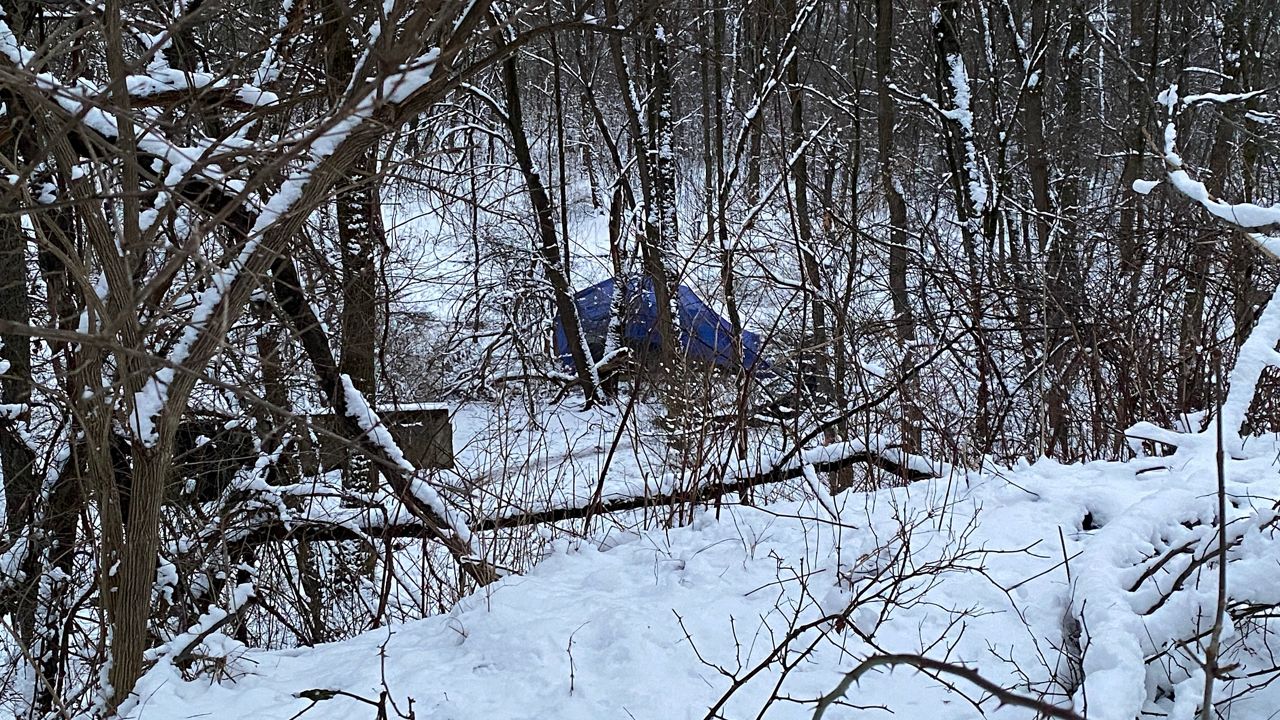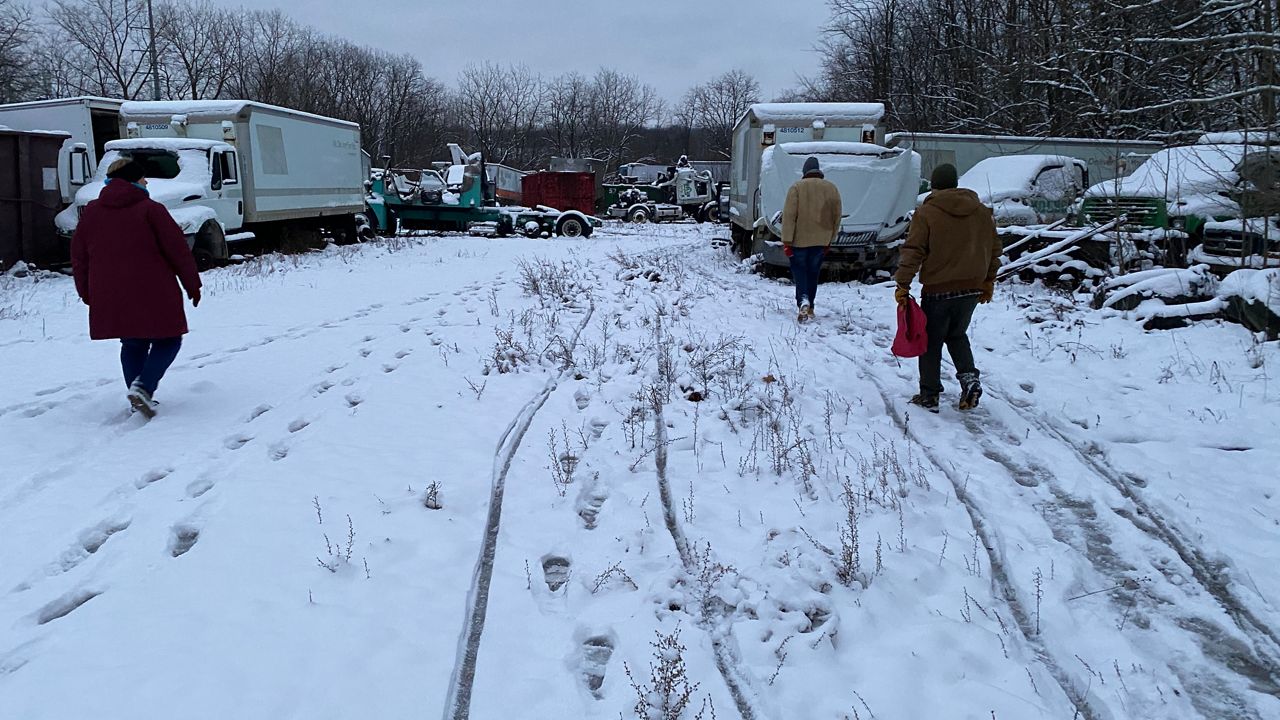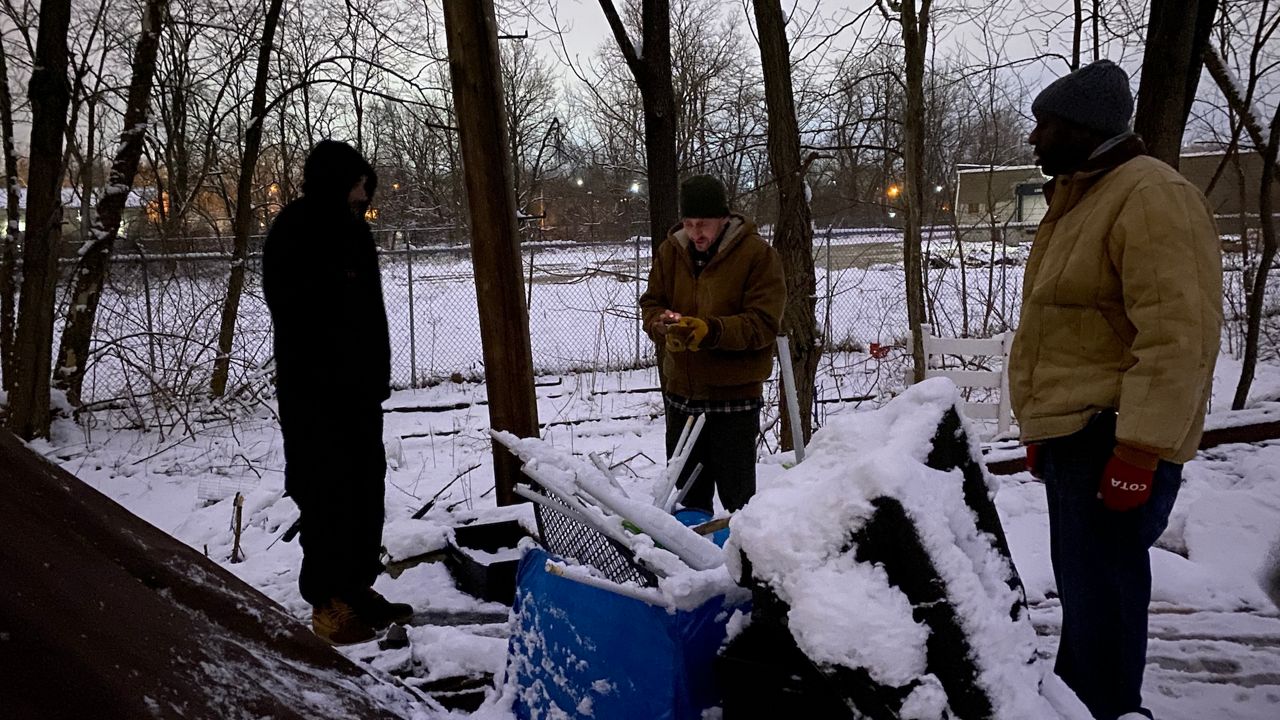SUMMIT COUNTY, Ohio — Each January, social workers layered in cold-weather gear divide into teams and, long before sunrise, strategically fan out across Summit County. They trek into woods, search along rivers and duck under bridges to conduct a federally mandated Point in Time head count of the county’s homeless.
The workers search shelters, bus stations and downtown skywalks during Ohio’s coldest month, looking anywhere a person might find warmth and relative safety on a cold winter night.
For Tim Edgar, Community Support Services residential manager, 20-plus years in the industry has given him a clear understanding of an evolving field that no longer mandates impossible standards homeless people must meet before they can be housed, he said.
When Edgar first started in street outreach, housing was scarce, so someone homeless might be required to achieve six months of sobriety before coming in from the cold, he said.
Now, getting people into housing is the top priority, ahead of addiction treatment, employment training and life skills that will come later, he said. While housing isn’t plentiful, it’s a better scenario than it once was.
Edgar oversees the team of 13 outreach workers who conduct the PIT. They are trained in specific disciplines, such as mental health, addiction, housing, peer support, and shelter operations. CSS also has a team dedicated to veterans.
The PIT is designed to count homeless adult residents, while a week-long count of homeless youths runs simultaneously. A more elusive group than their older counterparts, young people often couch surf or sleep in cars, moving between relatives and friends, social workers said.

Conducting the PIT is far from the only time workers are in the field — teams go out almost every day, with the entire team out on Thursdays, the workers said. The first Thursday of each month is a “night hike,” when the teams hit about 10 different camps to check on people.
For this year’s PIT, CSS employees doubled up on six teams, allowing city officials, journalists and others in authority to join them to learn more about the work.
With seven years in the field, licensed social worker Michael Harhager, a CSS supervisor, led one of the teams, along with coworker Keith Snodgrass, who’s also licensed. Snodgrass recently came to CSS after six years at Haven of Rest Ministries, a Christian-based agency that’s operated homeless shelters in Akron for 75 years.
Inspired to the work by a grandmother who ran group homes in Stark County, Snodgrass said he worked mostly in the shelter at the Haven, which he enjoyed. Now he’s working as part of the CSS street outreach team.

“I feel like I can be a greater help,” Snodgrass said. “It just makes the net larger. I can help people at the shelter and go out to people who don’t come in.”
Also in Harhager’s group was Mayor Dan Horrigan’s Chief of Staff Gert Wilms, who learned about the opportunity to ride along on the PIT from Mar-Quetta Boddie.
Since 2017, Boddie has served as the first executive director of Summit County’s Continuum of Care.
CoCs are a program of the U.S. Dept. of Housing and Urban Development, created though a mandate that counties receiving HUD funding to fight homelessness strategize and create a plan that addresses housing issues and works to keep people from returning to homelessness.
Summit County’s CoC unites more than 50 partner agencies — from CSS, the Hope & Healing Battered Women’s Shelter and the United Way of Summit and Medina Counties to the Peter Maurin Center, the Homeless Charity and Community Legal Aid — all expending resources to eliminate homelessness in Summit County.
According to the CoC’s 2021 annual report, 4,036 homeless residents received services in Summit County, with 774 of them children. Of those who moved into permanent housing, 97% stayed housed, the CoC said.

CSS is the CoC’s boots on the ground when it comes to street outreach.
During the PIT, Harhager’s group, like the other teams, had specific areas to search and a predetermined set of questions to ask each homeless person encountered.
In addition to age and initials, people were asked whether others live at the same site, whether they are fleeing domestic violence, whether substance abuse or mental is involved and their veteran status, among other questions.
The data goes into an app the social workers keep on their mobile devices, which feeds into a larger database that tracks, as best it can, the details on each homeless individual, Harhager said.
But before any questions are asked at a site, a respectful request to enter the camp area is issued.
“We’re not confrontational,” Harhager said. He calls the group’s approach “motivational interviewing.”
“We’re trying to help people recognize the change they want to see, getting away from telling people what they need and should do,” he said.
Many of the camps’ sleeping quarters are fashioned out of tarps in tent-like structures or domes. The camps are situated far from streets and sidewalks in wooded areas or under bridges in the city, so they are within walking distance of meal sites, bus transport and the warming centers the city opens on the coldest nights.

At one site, a soft-spoken young man politely gave his initials and age, but was clearly guarded, with arms wrapped around his middle and a hood pulled tight around his face.
Harhager respectfully asked the basic questions, and then asked the young man what services he might be interested in, such as meal locations, food stamps, laundry and shower facilities CSS operates and other amenities.
The teams carried backpacks to hand out, containing socks, gloves, a warm hat and toiletries, which the young man appeared grateful to receive. He listened politely to Harhager explain CSS services and or how to get to the offices. The man said he would consider looking into them and thanked him.
“The longer people are out the more challenging it is,” Harhager said.
On the way to another camp, the group came upon a man pulling a wagon with some of his possessions in it. It was the team’s second attempt to reach that site, spotted first from across a ravine at the bottom of a steep, ice-covered hill.
The 26-year-old man also listened politely to Harhager, hands shoved deep into his pockets, looking mostly at the ground.
“I don’t really like buildings,” the man said, explaining why he doesn’t go to meal sites. He’s been homeless four times, outside for the past year, and struggles with mental health issues.

The man perked up when Harhager said CSS could help him get healthcare, and the prescriptions the man said he needs. He listed losing his license, trouble paying auto insurance and lack of work as major stressors.
Once Harhager explained help is available, the man visibly brightened, extending his hand to shake the social worker’s. Upon learning a young woman also stayed at the camp, Wilms handed over a second backpack, which the man was clearly thankful for.
The men illustrated a common misperception — that everyone who’s on the street wants to be housed, CSS workers said.
The barriers many homeless people face — lack of income, addiction and active warrants — can seem insurmountable, causing them to stop believing they can be housed, Harhager said.
Sometimes, it’s generational and they’ve never been housed, so they don’t really know what it’s like, he said.
“If everybody wanted to be housed our jobs would be easy,” Harhager said.
Building trust is critical. Sometimes, clients will start with an easy request, such as help getting an ID, and if that works, maybe they’ll ask for more, Harhager said.
There’s often a sense of safety in a world homeless people believe they can control and change can bring fear, the social workers said.
Lezley Kijowski is a CSS residential treatment services administrator.
“Sometimes they’re afraid to get their own place because they’re afraid they’ll lose it,” she said.

Carl Slaton, who has been with CSS for seven years, agrees. Slaton serves as CSS housing liaison, dealing with everything from property managers to evictions.
“When you’re out on the street you know what your schedule is,” he said. “The difference is, you now have something to lose.”
What can make it worse are the paperwork and rules homeless people aren’t used to, he said.
“Here are all our rules,” Slaton said parodying a lease signing. “Here’s everything you do to get kicked out — sign here.”
In a new CSS position she’s worked for the past three months, Mikaylla Simms serves as a housing retention specialist, helping newly housed people gain the confidence, and eventually the skills, the need to stay there.
“We kind of meet them where they’re at,” Simms said, voicing what is a kind of mantra for CSS. “Our thought process is housing first, then be able to have the time to work on those other things.”
A sense of freedom and living off the grid is something some homeless people find appealing, Harhager said.
One man, a cheerful veteran who proudly said he is 55 and has lived outside for at least 15 years, seemed to exemplify that. Wearing cammo coveralls, he passed the group once, but circled back to chat.
The man said he uses a bow and arrow to hunt deer, and was looking for antlers to rattle to fool the deer during rutting season.
He turned down bus passes and other offerings, but enjoyed chatting while investigating the backpack. Carrying a 40-ounce beer in a plastic sack while sipping an open one, the man said he works closely with his church so he has no needs.
In the field, social workers operate under a strong set of ethics, Harhager said.
“Individuals have their own right to self-determination, to be able to make choices on their own,” he said. “Our obligation is to work alongside them, while looking out for people’s safety.”
To that end, if someone appears to be in danger in cold weather, or could pose a danger to others, licensed social workers are required to make a report, Harhager said.
That’s when they request assistance from a Crisis Intervention Team, composed of trained police officers.
According to Wilms, Akron has been training and deploying CITs for at least 20 years.
“A lot of these individuals are dealing with trauma and that effects how you engage with them and the services you can provide,” Harhager said. “CITs have a really good understanding of mental health and addiction, and bring a unique set of skills.”




